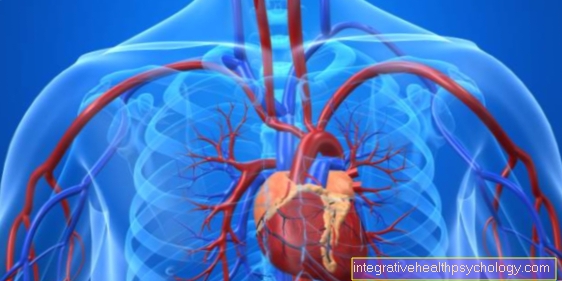Fox tapeworm
definition
The fox tapeworm (Echinococcus multilocularis) belongs to the type of tapeworm. The fox in its name is derived from the fact that it primarily attacks foxes and lives in them as a parasite. The foxworm can, however, also infect humans as part of a "bad colonization" and then lead to the disease echinococcosis.

Infection of humans is possible through ingestion of the fox tapeworm eggs which e.g. occur in fox droppings. The fox tapeworm occurs in Central Europe, including southern Germany. The dog tapeworm can also trigger echinococcosis, this form of echinococcosis is then called cystic echinococcosis. The disease is life-threatening if left untreated.
Transmission path
In addition to foxes as the main hosts, the tapeworm also infects dogs and domestic cats. Small mice can be used as intermediate hosts. The fox often becomes infected by eating infected mice. Infection of humans is only possible through ingestion of fox tapeworm eggs.
These eggs are excreted with the faeces of the infected animals. They can also stick to animal fur. Possible transmission routes are contaminated food or eating with dirty hands. Contact with the fur of infected animals e.g. petting the human can become infected.
Furthermore, the inhalation of contaminated dust, for example in the context of haymaking, is also considered as a possible transmission path. According to the current state of affairs, the one-time ingestion of the fox tapeworm eggs does not immediately lead to infection, but only the long-term exposure, i.e. the recurring ingestion of the eggs. According to an evaluation of the data on the infected patients in Europe, the majority of them either belonged to the group of farmers, worked a lot in the garden or had their own pets.
Distribution of the fox tapeworm
The fox tapeworm lives in (cold) temperate climates in the northern hemisphere. It is common in Russia, Central Asia, China, Japan, parts of Turkey, Iran and India and in parts of Europe. In Europe, it is mainly found in parts of France, parts of Austria, parts of Switzerland and parts of Germany.
The fox tapeworm is often found in the south of Germany in the Swabian Alb area. The number of infected foxes varies greatly. While over 70% of the foxes are infected in south-west Germany, it is only about 27% in Upper Bavaria. In Switzerland, almost 50% of foxes are infected with the fox tapeworm.
diagnosis
A blood test and imaging tests are often done if a fox tapeworm is suspected. Antibodies can be searched for in the blood that are only present if contact with the parasite has taken place. So there is no specific value that can be determined in a standard blood test, but immunological blood test methods are used to make certain antibodies visible.
Imaging methods are used for further diagnostics because the fox tapeworm can attack numerous internal organs, above all the liver. Infected liver foci can be identified - depending on the size - with an ultrasound examination of the abdomen.
If conspicuous areas are found here, other imaging methods such as computed tomography (CT) or magnetic resonance tomography / magnetic resonance imaging (MRT) can be used. Echinococcosis is not infrequently an incidental finding because an ultrasound / CT / MRT examination of the abdomen was made for another reason. Differentiating between dog and fox tapeworms is rather difficult using blood tests. A histological examination of surgical material enables differentiation.
Concomitant symptoms
The incubation period (= time between infection and appearance of the first symptoms) is 5 to 15 years. So it often takes a long time before the first symptoms appear. After ingestion, the ingested eggs can pass through the bloodstream to various organs. The liver is most frequently affected, but the spleen, gallbladder and bile ducts, lungs and brain are also possible. Here the eggs spread through the budding of cysts. Other organs can be infected via the blood; there is talk of metastasis.
This term is usually used to describe the spread of malignant cancer cells through the blood or lymphatic system to other organs. This is because echinococcosis resembles a malignant cancer in its spread pattern. If left untreated, it will lead to death sooner or later. The formation of cysts and their spread through the bloodstream often cause no symptoms. The involvement of the liver can be accompanied by unspecific upper abdominal complaints, one of the most common symptoms of alveolar echinococcosis.
Even after many years, the other possible symptoms are rather unspecific: exhaustion, fatigue, increased tiredness, stomach pain, weight loss and jaundice (yellowing of the skin due to biliary blockage). This can lead to secondary diseases such as inflammation of the bile ducts, sepsis, portal hypertension with its complications (see below), thrombosis, inflammation of the kidneys up to loss of function (glomerulonephritis), liver insufficiency up to liver failure and embolisms.
Upper abdominal pain
Upper abdominal pain can often occur as part of a fox tapeworm infection. They represent an unspecific symptom and are caused by the disease in the liver. They can be an indication of numerous other - and much more common - diseases such as gastric mucosal inflammation, gastric ulcer, gallstones, gallbladder inflammation or pancreatitis.
Jaundice
Jaundice is also a possible symptom of alveolar echinococcosis. This describes the yellowing of the skin and eyes (the whites of the eyes (sclera) turn yellow). In technical jargon, one speaks of jaundice. It can have various causes.
When infected with the fox tapeworm, the most common cause of jaundice is the spread of the pathogen that causes biliary congestion. The bile pigment bilirubin cannot flow away with the bile as usual and the skin turns yellow.
Portal hypertension
Portal hypertension or portal hypertension describes an increase in pressure in the portal vein. The portal vein is a large vein that arises from the confluence of several veins that collect the blood from the gastrointestinal tract and the spleen and return it to the heart via the liver.
When the fox tapeworm is infected, the cause of the increased pressure in the portal vein is due to the compression of a vein. The most important possible complications of portal hypertension are: The formation of esophageal varices with the risk of life-threatening bleeding in the area of the esophagus.
There may also be a lack of detoxification function by the liver, as the blood can no longer flow sufficiently through the liver. This can lead to encephalopathy. This means that those affected can stand out with psychological symptoms such as confusion, disorientation and severe tremors. Heptic encephalopathy is often fatal if left untreated.
Read more about diseases of the liver here.
What treatment options are there?
Depending on how early the disease was diagnosed and how far it has progressed, there are different therapeutic approaches. Drug therapy is usually necessary. The drugs belong to the group of benzimidazoles.
The active ingredients albendazole and mebendazole are used. These inhibit the growth of parasites. According to current knowledge, however, they do not kill the parasites in the process. Since they only inhibit growth, some of them have to be taken permanently, otherwise the pathogens will continue to multiply.
Since the diagnosis is made very late in many patients, the only therapeutic alternative that can bring about a cure is often no longer an option, namely surgery. If the pathogens have already spread through the bloodstream to numerous organs, i.e. have metastasized, an operation no longer makes sense, as is the case with cancer. As a rule, drug therapy is carried out.
When do you need an operation?
An operation is always the method of choice. The earlier the disease is diagnosed, the higher the chance that it has not spread too far and that the infected areas can be surgically removed. If the disease is recognized late, metastasis has usually already occurred so that surgical therapy can no longer lead to a cure. Then an operation is only indicated if a particular focus causes severe discomfort and should therefore be removed.
Healing time
As already described, many patients can no longer be cured because the disease is too far advanced when the diagnosis is made. The duration of treatment varies from case to case and depends on how far the fox tapeworm has already spread. Therefore, no general statement can be made about the healing time.
Which doctor treats this?
For the treatment of alveolar echinococcosis, it is advisable to visit a center. Since the infection with the fox tapeworm is a relatively rare disease with 20-30 new cases per year in Germany, there are centers that specialize in the treatment of the disease and have a lot of experience. An example of such a center would be the Heidelberg University Hospital.
Can you kill the fox tapeworm completely?
In theory, a cure for alveolar echinococcosis is possible. However, only in the early stages and with the help of a complete surgical removal of all possible pathogens. In advanced stages of the disease, it is usually no longer possible to completely kill the fox tapeworm.
Can you kill a fox tapeworm by freezing it?
The fox tapeworm is very resilient. For example, it cannot be killed by disinfectants. Temperatures of - 80 ° C for a few days or over 60 ° C for a few minutes (heating) are suitable for killing the infectious eggs.
How long is the incubation period for the fox tapeworm?
The incubation period is given as 5-15 years. This has to do with the fact that the pathogens multiply very slowly at the beginning and it takes a relatively long time for them to cause symptoms. Often a large part of the liver has already been infiltrated by the parasites and metastasis has occurred. Evidence of the disease by blood tests is, however, possible before symptoms appear (i.e. before the incubation period has expired). Probably a few months after infection, antibodies can be detected in the blood that indicate an infection.
Is the fox tapeworm contagious?
The fox tapeworm cannot be transmitted from person to person.
What are the signs of the fox tapeworm?
Since the pathogen reproduces very slowly, the first symptoms often only appear years after the infection. There are no specific signs. Therefore, all people should pay attention to hygienic measures (washing food, hand hygiene). Hunters should be careful not to touch foxes that have been shot with protective gloves. Dogs should be dewormed regularly. Dogs that are used for hunting, especially in fox burrows, should be showered very thoroughly afterwards.
What are the consequences of the fox tapeworm?
The complications that can arise from an infection with the fox tapeworm are already listed under the symptoms. As a general rule, untreated alveolar echinococcosis leads to death sooner or later. Diagnosis and therapy are therefore crucial.
Additional informationFor more information, please read:
- Worms in the intestines
- Medicines for worms
- Parasites of humans
- Unintended weight loss
- stomach pain























.jpg)





